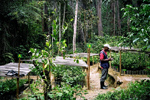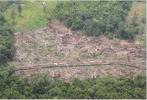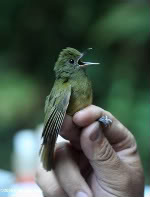A new analysis reports that ecological restoration generally deliver benefits for both conserving biodiversity and supporting human livelihoods, but does not completely reverse degradation caused by humans.
The research, published in Science, examined 89 studies and found that ecological restoration increased provision of biodiversity and ecosystem services by 44 percent and 25 percent respectively. Values of both, however, remained lower in restored than in intact reference ecosystems. Still Jose Rey Benayas and colleagues are encouraged that restoration projects could become increasingly viable under emerging payments for environmental services schemes like the Reducing Emissions from Deforestation and Degradation (REDD) mechanism proposed for a post-Kyoto climate agreement. Such initiatives, which could compensate developing countries for protecting and restoring ecosystems, could simultaneously deliver benefits to the environment and local communities.
The authors suggest the development of cost-benefit analyses that incorporate the values of biodiversity and associated ecosystem services could help “maximize return on investments in restoration.”
José M. Rey Benayas, Adrian C. Newton, Anita Diaz, James M. Bullock. “Enhancement of Biodiversity and Ecosystem Services by Ecological Restoration: A Meta-Analysis.” Science 31 July 2009
Related articles
Forest Recovery Programs in Madagascar

(06/01/2009) Despite being one of the last habitable land masses on earth to be settled by man, Madagascar has lost more of its forests than most countries; less than 10% of its original forest cover now remains, and much of that is degraded. Political turmoil that erupted earlier this year continues to rumble on and the ensuing lawlessness has created the opportunity for illegal logging syndicates to plunder national parks, most notably Marojejy and Masoala, for valuable hardwoods and wildlife.
Polluted, degraded ecosystems can recover in less than a lifetime

(05/31/2009) Restoration efforts can return polluted or degraded landscapes to previous states in less than a lifetime, according to study Yale School of Forestry and Environmental Studies. The study rebuts a common assumption that ecosystem recovery takes centuries, even millennia.
Could engineering rainforests save the planet from global warming?
(01/21/2009) At the Smithsonian symposium entitled “Will the Rainforests Survive?”, leading tropical biologists vigorously debated current threats to the rainforest and what the future may hold. While climate change was identified as a leading threat to rainforests, many of the scientists argued that the tropics may also be the key to mitigating the impact of global warming.
Secondary forest should become new conservation initiative

(01/19/2009) “I want to convince you we need to go beyond primary forests to preserve biodiversity”, Robin Chazdon told an audience at the National Natural History Museum during a symposium on the tropics. Chazdon, a professor of ecology and evolutionary biology at the University of Connecticut, has been studying secondary growth forests for over eighteen years. Secondary forests are those forests in the process of regrowth after being used for agriculture or logging. In her study area of NE Costa Rica, many of these forests were converted to pastures in the 1970s and 1980s, but have since been abandoned. In her presentation Chazdon argued that to preserve biodiversity numerous types of human-impacted landscapes, such as secondary forest, require attention by the conservation community.
Regrowing the Amazon rainforest will require help from bats and birds
(09/15/2008) As large tracts of Amazon rainforest are degraded by industrial logging and cleared for cattle pasture and agriculture, other deforested areas are abandoned and being reclaimed by forest. Understanding this recolonization of degraded forest lands by pioneer species will critical to efforts to rehabilitate restore forests around the world.
Reforestation a growing, but complicated, initiative
(06/12/2008) As the rate of deforestation continues apace — 13 million hectares per year in a global basis — several countries have begun to look at reforesting degraded areas to aid suffering biodiversity, indigenous groups, and small local economies. However most of the interest and activity surrounding reforestation is as a tool to mitigate climate change. A new program just launched by the Nature Conservancy and several local partners plans to plant a billion trees in the fragmented Atlantic Forest of Brazil. The United Nations Environmental Program has already planted over two billion trees worldwide and plans to plant five billion more. China has planted billions more. However effective reforestation is not proving as easy as simply planting trees and waiting for them to grow, in fact, sometimes it may be best to leave the whole process to nature.